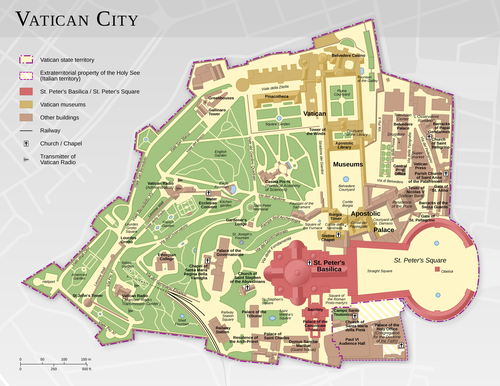
The Pontifical Military Corps, except for the Swiss Guard, was disbanded by will of Paul VI, as expressed in a letter of 14 September 1970. The Gendarmerie Corps was transformed into a civilian police and security force.
In 1984, a new concordat between the Holy See and Italy modified certain provisions of the earlier treaty, including the position of Catholic Christianity as the Italian state religion, a position given to it by a statute of the Kingdom of Sardinia of 1848.
Construction in 1995 of a new guest house, Domus Sanctae Marthae, adjacent to St Peter’s Basilica was criticized by Italian environmental groups, backed by Italian politicians. They claimed the new building would block views of the Basilica from nearby Italian apartments. For a short while the plans strained the relations between the Vatican and the Italian government. The head of the Vatican’s Department of Technical Services robustly rejected challenges to the Vatican State’s right to build within its borders.
Geography:
The name “Vatican” was already in use in the time of the Roman Republic for the Ager Vaticanus, a marshy area on the west bank of the Tiber across from the city of Rome, located between the Janiculum, the Vatican Hill and Monte Mario, down to the Aventine Hill and up to the confluence of the Cremera creek. The territory of Vatican City is part of the Vatican Hill, and of the adjacent former Vatican Fields. It is in this territory that St. Peter’s Basilica, the Apostolic Palace, the Sistine Chapel, and museums were built, along with various other buildings. The area was part of the Roman rione of Borgo until 1929. Being separated from the city, on the west bank of the river Tiber, the area was an outcrop of the city that was protected by being included within the walls of Leo IV (847–855), and later expanded by the current fortification walls, built under Paul III (1534–1549), Pius IV (1559–1565), and Urban VIII (1623–1644).

When the Lateran Treaty of 1929 that gave the state its form was being prepared, the boundaries of the proposed territory were influenced by the fact that much of it was all but enclosed by this loop. For some tracts of the frontier, there was no wall, but the line of certain buildings supplied part of the boundary, and for a small part of the frontier a modern wall was constructed.
The territory includes St. Peter’s Square, distinguished from the territory of Italy only by a white line along the limit of the square, where it touches Piazza Pio XII. St. Peter’s Square is reached through the Via della Conciliazione which runs from close to the Tiber to St. Peter’s. This grand approach was constructed by Benito Mussolini after the conclusion of the Lateran Treaty.
According to the Lateran Treaty, certain properties of the Holy See that are located in Italian territory, most notably the Papal Palace of Castel Gandolfo and the major basilicas, enjoy extraterritorial status similar to that of foreign embassies. These properties, scattered all over Rome and Italy, house essential offices and institutions necessary to the character and mission of the Holy See.
Castel Gandolfo and the named basilicas are patrolled internally by police agents of Vatican City State and not by Italian police. According to the Lateran Treaty (Art. 3) St. Peter’s Square, up to but not including the steps leading to the basilica, is normally patrolled by the Italian police.
